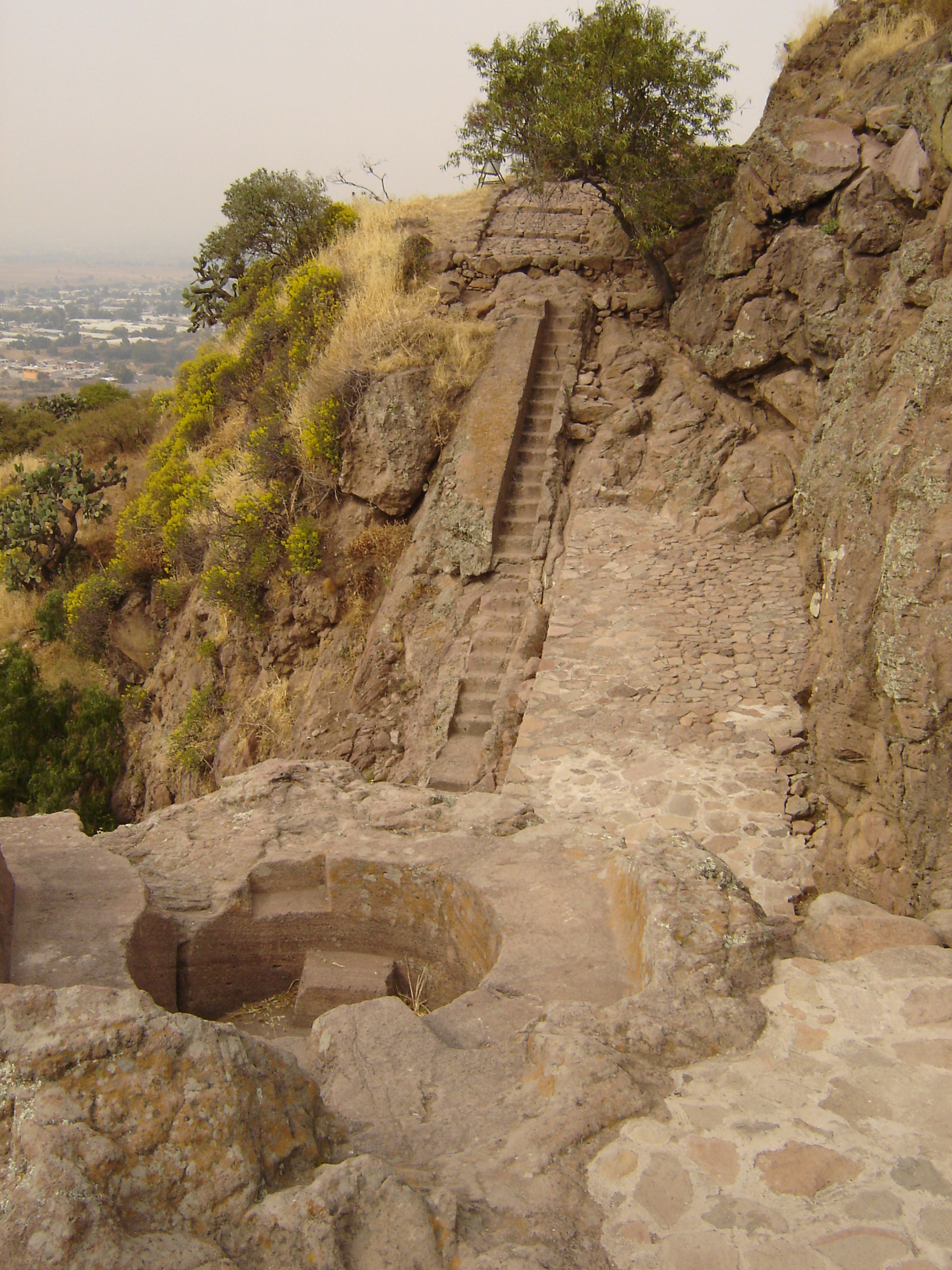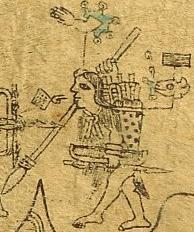|
Ixtlilxochitl I
Ixtlilxochitl Ome Tochtli (1380-1418) was the ruler (''tlatoani'') of the Acolhua city-state of Texcoco from 1409 to 1418 and the father of the famous "poet-king" Nezahualcoyotl. Early years as ''tlatoani'' Claiming descent from the legendary Chichimec chieftains King Xolotl and Nopaltzin, Ixtlixochitl became ''tlatoani'' of Texcoco in 1409 after the death of his father, Techotlala. For several years thereafter, Ixtlilxochitl continued to pay tribute to the powerful Tepanec city of Azcapotzalco and its ''tlatoani'' Tezozomoc. However, Ixtlilxochitl grew restive in this role and, in preference to Tezozomoc's daughter, married the Mexica princess Matlalcihuatzin, a daughter of Huitzilihuitl, ''tlatoani'' of Tenochtitlan.Radin, Paul; "The sources and authenticity of the history of the ancient Mexicans" in ''University of California Publications in American Archaeology and Ethnology'', June 1920, Vol. 17 No. 1, In 1414, Ixtlilxochitl took the title ''Chichimeca Tecuhtli'' ("Lo ... [...More Info...] [...Related Items...] OR: [Wikipedia] [Google] [Baidu] |
Codex Ixtlilxochitl
Aztec codices ( nah, Mēxihcatl āmoxtli , sing. ''codex'') are Mesoamerican manuscripts made by the pre-Columbian Aztec, and their Nahuatl-speaking descendants during the colonial period in Mexico. History Before the start of the Spanish colonization of the Americas, the Mexica and their neighbors in and around the Valley of Mexico relied on painted books and records to document many aspects of their lives. Painted manuscripts contained information about their history, science, land tenure, tribute, and sacred rituals. According to the testimony of Bernal Díaz del Castillo, Moctezuma had a library full of such books, known as ''amatl'', or ''amoxtli,'' kept by a ''calpixqui'' or nobleman in his palace, some of them dealing with tribute. After the conquest of Tenochtitlan, indigenous nations continued to produce painted manuscripts, and the Spaniards came to accept and rely on them as valid and potentially important records. The native tradition of pictorial document ... [...More Info...] [...Related Items...] OR: [Wikipedia] [Google] [Baidu] |
Mexica
The Mexica (Nahuatl: , ;''Nahuatl Dictionary.'' (1990). Wired Humanities Project. University of Oregon. Retrieved August 29, 2012, frolink/ref> singular ) were a Nahuatl-speaking indigenous people of the Valley of Mexico who were the rulers of the Aztec Empire. The Mexica established Tenochtitlan, a settlement on an island in Lake Texcoco, in 1325. A dissident group in Tenochtitlan separated and founded the settlement of Tlatelolco with its own dynastic lineage. In 1521, they were conquered by an alliance of Spanish conquistadors and indigenous people including the Tlaxcaltecs led by Hernán Cortés. Names The ''Mexica'' are eponymous of the place name Mexico (''Mēxihco'' ), originally referring to the interconnected settlements in the valley that is now Mexico City. The group was also known as the Culhua-Mexica in recognition of its kinship alliance with the neighboring Culhua, descendants of the revered Toltecs, who occupied the Toltec capital of Tula from the 10th to ... [...More Info...] [...Related Items...] OR: [Wikipedia] [Google] [Baidu] |
Tlatoque Of Texcoco
This is a list of Mesoamerican rulers of the ''altepetl'' of Tetzcoco from the time the city began being ruled by ''tlatoque'' in 1298 to the end of the line of indigenous rulers. From the early 15th century to 1521, Tetzcoco was one of the three leading members of the Triple Alliance, commonly known as the Aztec Empire, but was often subservient to the rulers of Tenochtitlan. The Aztec Empire was conquered by Spain in 1521, but the Spanish colonial authorities continued to appoint ''tlatoque'' of Tetzcoco until the office was abolished in 1564. Pre-colonial rulers (1298–1521) Early Tetzcoco (1298–1431) The ''tlatoque'' of Tetzcoco were descendants and successors of earlier ''tlatoque'' of the Chichimeca, succeeding Xolotl (1172–1232), Nopaltzin (1232–1263) and Tlotzin (1263–1298). In the Triple Alliance (1431–1521) Colonial period (1521–1564) The line of ''tlatoque'' continued in Tetzococo after the Spanish conquest. Adept at navigating the new Span ... [...More Info...] [...Related Items...] OR: [Wikipedia] [Google] [Baidu] |
Texcoco (altepetl)
Tetzcoco (Classical Nahuatl: ''Tetzco(h)co'' ) was a major Acolhua altepetl (city-state) in the central Mexican plateau region of Mesoamerica during the Late Postclassic period of pre-Columbian Mesoamerican chronology. It was situated on the eastern bank of Lake Texcoco in the Valley of Mexico, to the northeast of the Aztec capital, Tenochtitlan. The site of pre-Columbian Tetzcoco is now subsumed by the modern Mexican ''municipio'' of Texcoco and its major settlement, the city formally known as Texcoco de Mora. It also lies within the greater metropolitan area of Mexico City. Pre-Columbian Tetzcoco is most noted for its membership in the Aztec Triple Alliance. At the time of the Spanish conquest of the Aztec Empire, it was one of the largest and most prestigious cities in central Mexico, second only to the Aztec capital, Tenochtitlan. A survey of Mesoamerican cities estimated that pre-conquest Tetzcoco had a population of 24,000+ and occupied an area of 450 hectares. The ... [...More Info...] [...Related Items...] OR: [Wikipedia] [Google] [Baidu] |
Tlatoque
''Tlatoani'' ( , "one who speaks, ruler"; plural ' or tlatoque) is the Classical Nahuatl term for the ruler of an , a pre-Hispanic state. It is the noun form of the verb "tlahtoa" meaning "speak, command, rule". As a result, it has been variously translated in English as "king", "ruler", or "speaker" in the political sense. Above a tlahtoani is the ''Weyi Tlahtoani,'' sometimes translated as "Great Speaker", though more usually as "Emperor" (the term is often seen as the equivalent to the European "great king"). A ' () is a female ruler, or queen regnant. The term refers to "vice-leader". The leaders of the Mexica prior to their settlement are sometimes referred to as , as well as colonial rulers who were not descended from the ruling dynasty. The ruler's lands were called , and the ruler's house was called ''Nahuatl dictionary'' (1997). Wired humanities project. Retrieved January 1, 2012, frolink/ref> The city-states of the Aztec Empire each had their own tlatoani, or lea ... [...More Info...] [...Related Items...] OR: [Wikipedia] [Google] [Baidu] |
Tlatoani Of Texcoco
This is a list of Mesoamerican rulers of the ''altepetl'' of Tetzcoco from the time the city began being ruled by ''tlatoque'' in 1298 to the end of the line of indigenous rulers. From the early 15th century to 1521, Tetzcoco was one of the three leading members of the Triple Alliance, commonly known as the Aztec Empire, but was often subservient to the rulers of Tenochtitlan. The Aztec Empire was conquered by Spain in 1521, but the Spanish colonial authorities continued to appoint ''tlatoque'' of Tetzcoco until the office was abolished in 1564. Pre-colonial rulers (1298–1521) Early Tetzcoco (1298–1431) The ''tlatoque'' of Tetzcoco were descendants and successors of earlier ''tlatoque'' of the Chichimeca, succeeding Xolotl (1172–1232), Nopaltzin (1232–1263) and Tlotzin (1263–1298). In the Triple Alliance (1431–1521) Colonial period (1521–1564) The line of ''tlatoque'' continued in Tetzococo after the Spanish conquest. Adept at navigating the new Span ... [...More Info...] [...Related Items...] OR: [Wikipedia] [Google] [Baidu] |
Itzcoatl
Itzcoatl ( nci-IPA, Itzcōhuātl, it͡sˈkoːwaːt͡ɬ, "Obsidian Serpent", ) (1380–1440) was the fourth king of Tenochtitlan, and the founder of the Aztec Empire, ruling from 1427 to 1440. Under Itzcoatl the Mexica of Tenochtitlan threw off the domination of the Tepanecs and established the Triple Alliance (Aztec Empire) together with the other city-states Tetzcoco and Tlacopan. Biography Itzcoatl was the natural son of ''tlàtoāni'' Acamapichtli and an unknown Tepanec woman from Azcapotzalco. He was elected as the king when his predecessor, his nephew Chimalpopoca, was killed by Maxtla of the nearby Tepanec ''āltepētl'' (city-state) of Azcapotzalco. Allying with Nezahualcoyotl of Texcoco, Itzcoatl went on to defeat Maxtla and end the Tepanec domination of central Mexico. After this victory, Itzcoatl, Nezahualcoyotl, and Totoquilhuaztli, king of Tlacopan, forged what would become known as the Aztec Triple Alliance, forming the basis of the eventual Aztec Empire. Itzc ... [...More Info...] [...Related Items...] OR: [Wikipedia] [Google] [Baidu] |
Mount Tlaloc
Mount Tlaloc (Spanish: Monte Tláloc, sometimes wrongly listed as ''Cerro el Mirador''; Nahuatl: ''Tlālōcatepētl'') is a mountain and archaeological site in central Mexico. It is located in the State of Mexico, in the municipalities of Ixtapaluca and Texcoco, close to the state border with Puebla. Formerly an active volcano, it has an official altitude of above sea level, thus being the 9th tallest mountain of Mexico. The mountain was considered by the Nahuan peoples, foremost among them the Aztecs, to be specially sacred to the raingod Tlaloc. In fact, the mountain was believed to be one of his primary earthly dwelling places, called Tlalocan. Attribution of this and other mountains to the sacred presence of rain deities predates the Aztec era by centuries, even millennia. At the summit there are still remains of a shrine where high ceremonies would have been carried out. The rites of Tlaloc were otherwise performed at his temples, most famously that occupying one half of ... [...More Info...] [...Related Items...] OR: [Wikipedia] [Google] [Baidu] |
Aztec
The Aztecs () were a Mesoamerican culture that flourished in central Mexico in the post-classic period from 1300 to 1521. The Aztec people included different Indigenous peoples of Mexico, ethnic groups of central Mexico, particularly those groups who spoke the Nahuatl, Nahuatl language and who dominated large parts of Mesoamerica from the 14th to the 16th centuries. Aztec culture was organized into city-states (''altepetl''), some of which joined to form alliances, political confederations, or empires. The Aztec Empire was a confederation of three city-states established in 1427: Tenochtitlan, city-state of the Mexica or Tenochca; Texcoco (altepetl), Texcoco; and Tlacopan, previously part of the Tepanec empire, whose dominant power was Azcapotzalco (altepetl), Azcapotzalco. Although the term Aztecs is often narrowly restricted to the Mexica of Tenochtitlan, it is also broadly used to refer to Nahuas, Nahua polities or peoples of central Pre-Columbian Mexico, Mexico in the preh ... [...More Info...] [...Related Items...] OR: [Wikipedia] [Google] [Baidu] |
Tenochtitlan
, ; es, Tenochtitlan also known as Mexico-Tenochtitlan, ; es, México-Tenochtitlan was a large Mexican in what is now the historic center of Mexico City. The exact date of the founding of the city is unclear. The date 13 March 1325 was chosen in 1925 to celebrate the 600th anniversary of the city. The city was built on an island in what was then Lake Texcoco in the Valley of Mexico. The city was the capital of the expanding Aztec Empire in the 15th century until it was captured by the Spanish in 1521. At its peak, it was the largest city in the pre-Columbian Americas. It subsequently became a '' cabecera'' of the Viceroyalty of New Spain. Today, the ruins of are in the historic center of the Mexican capital. The World Heritage Site of contains what remains of the geography (water, boats, floating gardens) of the Mexica capital. was one of two Mexica (city-states or polities) on the island, the other being . The city is located in modern-day Mexico City. Etymolo ... [...More Info...] [...Related Items...] OR: [Wikipedia] [Google] [Baidu] |
Huitzilihuitl
Huitzilihuitl or Huitzilihuitzin (Nahuatl language; English: ''Hummingbird Feather'') (1370s – ''ca.'' 1417) was the second ''Tlatoani'' or king of Tenochtitlan. According to the Codex Chimalpahin, he reigned from 1390 to 1415, according to the Codex Aubin, he reigned from 1396 to 1417 and according to the Codex Chimalpopoca, he reigned from 1403 to 1417. Biography Family and childhood Huitzilíhuitl was born in Tenochtitlan, and was the son of Acamapichtli, first ''tlatoani'' of the Mexica, and Queen Tezcatlan Miyahuatzin, and had a half-brother Itzcoatl. His maternal grandfather was Acacitli. Only 16 years old when his father died, Huitzilihuitl was elected by the principal chiefs, warriors and priests of the city to replace him. At that time, the Mexica were tributaries of the Tepanec city-state of Azcapotzalco. Reign Huitzilíhuitl, a good politician, continued the policies of his father, seeking alliances with his neighbors. He founded the Royal Council or ''Tlato ... [...More Info...] [...Related Items...] OR: [Wikipedia] [Google] [Baidu] |








